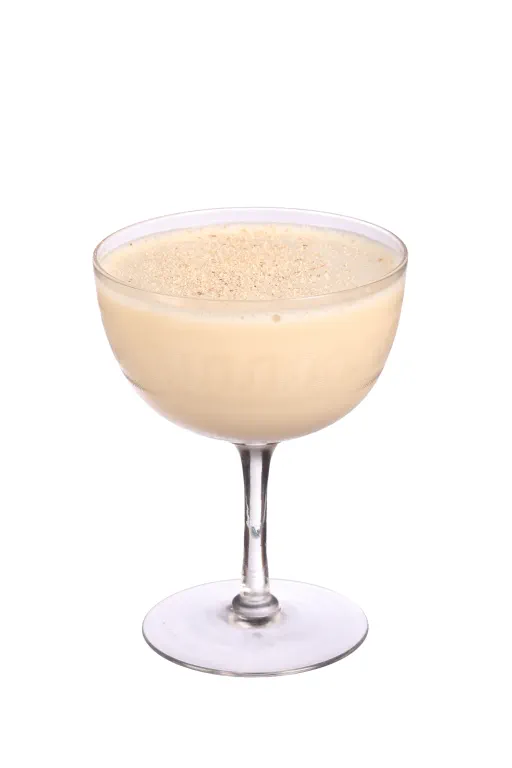Are you a Discerning Drinker?
Join thousands of like-minded professionals and cocktail enthusiasts, receive our weekly newsletters and see pages produced by our community for fellow Discerning Drinkers.
Alexander

Glass:
Serve in a Coupe glass
| 1 1⁄2 oz | Hayman's London Dry Gin |
| 3⁄4 oz | White crème de cacao liqueur |
| 3⁄4 oz | Single cream/half-and-half |
| 1⁄3 oz | Egg white (pasteurised) or 3 dashes Fee Brothers Fee Foam cocktail foamer optional |
Prepare:
- Select and pre-chill a COUPE GLASS.
- Prepare garnish of grated nutmeg.
How to make:
- DRY SHAKE all ingredients (without ice) to emulsify.
- SHAKE again with ice.
- FINE STRAIN into chilled glass.
Garnish:
- Dust with freshly grated nutmeg.
Allergens:
Recipe contains the following allergens:
Strength & taste guide:

17th January 2025 is The day Prohibition started
Review:
This gin-laced creamy Alexander has sadly slipped from popularity, partly knocked by its successors, particularly the Brandy Alexander.
AKA: Alexander No. 1, Gin Alexander, Princess Mary
Variant:
Without egg white this becomes a Princess Mary, but as Stanley Clisby Arthur explains in his 1937 Famous New Orleans Drinks and How to Mix 'em, it's a lesser cocktail. "Smooth as cream, delicate as dew, and easily prepared is the Alexander. Some who mix this particular cocktail do not use the white of egg. A mistake, for the albumen gives a froth and an added smoothness which makes this cocktail different. Like all drinks in which egg white is used vigorous shaking is required. Give the Alexander all you've got in elbow grease to make it live up to its reputation - for it is truly Alexander the Great among drinks in its class."
History:
The Alexander, comprising gin, crème de cacao and cream, is thought to have originated early in the 20th century, certainly before 1915, evidenced by an equal parts recipe appearing in Hugo Ensslin's 1916 Recipes for Mixed Drinks.
Historian, Barry Popik's website lists several plausible origins for this drink. The first is a cutting from page 11 of the news section of the 3rd October 1915 Philadelphia Inquirer. "The head bartender has even gone so far as to invent an Alexander cocktail, which he is reserving to be served during the World Series." This referred to The Racquet Club and the 1915 World Series, won by Boston beating Philadelphia. The bartender created the drink honouring Philadelphia pitcher Grover Cleveland Alexander (1887-1950).
Alternatively, a 21st March 1929 newspaper column by New York columnist Walter Winchell links the origin of the Alexander cocktail to Troy Alexander, a bartender at a New York pre-Prohibition lobster restaurant called Rector's. It claims that Troy created his eponymously named cocktail for a dinner celebrating a successful advertising campaign.
The advertisement depicted Phoebe Snow, a fictitious railway traveller, wearing a snow-white dress featured in an advertising campaign for the Delaware, Lackawanna and Western Railroad (DL&W) to promote the company's use of clean-burning anthracite to fuel its locomotives.
Coal-fuelled trains frequently covered travellers with black soot, but DL&W owned vast anthracite mines in Pennsylvania, so they could legitimately claim that their passengers would arrive clean after a long journey. The first advertisement depicted an image of Phoebe Snow, supposedly a young New York socialite who frequently travelled to Buffalo, New York, wearing a white dress and featured a short poem:
Says Phoebe Snow
about to go
upon a trip to Buffalo
"My gown stays white
from morn till night
Upon the Road of Anthracite"
The popular advertisements first appeared at the turn of the 20th century and ran for nearly 70 years. Phoebe became one of America's most recognized advertising mascots. The Alexander became a Prohibition favourite as the cream and nutmeg garnish helped disguise the rough taste of homemade 'bathtub' gin.
ALEXANDER COCKTAIL
Hugo Ensslin, Recipes for Mixed Drinks, 1916
⅓ El Bart Gin
⅓ Crème de Cocoa
⅓ Sweet Cream
Shake well in a mixing glass with cracked ice, strain and serve.
Nutrition:
One serving of Alexander contains 210 calories
Alcohol content:
- 1.3 standard drinks
- 17.77% alc./vol. (35.54° proof)
- 17.8 grams of pure alcohol
- More Classic/vintage cocktails
- More Creamy (e.g. Dirty banana) cocktails
- More Dessert cocktails cocktails
- More Hall of Fame & must know/try cocktails
Difford’s Guide remains free-to-use thanks to the support of the brands in green above. Values stated for alcohol and calorie content, and number of drinks an ingredient makes should be considered approximate.

Alessandro

Alexander The Great

Alexander cocktails
The original Alexander cocktail consisted of equal parts gin, crème de cacao liqueur and cream. Over time, other spirits were substituted for the gin...
Chocolate & crème de cacao liqueurs
Chocolate, in all its forms, from an intense dark block to sweet melted fondue, has had a spell over our taste buds since the Olmec people in Mesoamerica...
Prohibition
America's national Prohibition lasted from 1920 to 1933 and was supported by groups as diverse as the Christian Women's Temperance Movement and the Ku...
Egg dos and don'ts & using eggs in cocktails
Eggs are essentially reproductive cells from everything from chickens to ducks and quails but here I'm specifically looking at chicken eggs, their characteristics...
20 best Halloween cocktails
All Hallows' Eve, the 31st of October, is spook night with bizarre costumes, trick-or-treat, pumpkin carving, apple bobbing and bonfires all the rage...




Join the discussion
Showing 3 comments for Alexander.
See discussion in the Forum